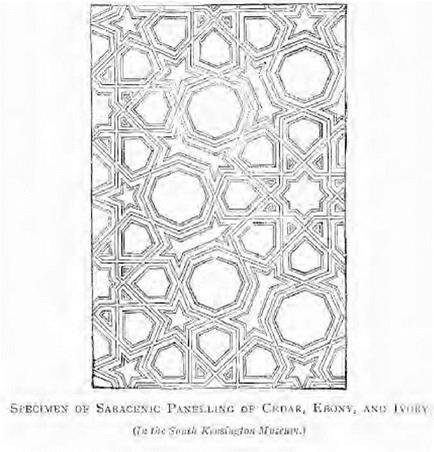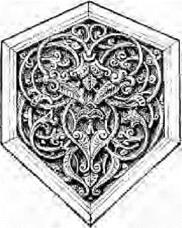While the changes of fashion in Western, as contrasted with Eastern countries, are comparatively rapid, the record of two or three centuries presenting a history of great and well-defined alterations in manners, customs, and therefore, of furniture, the more conservative Oriental has been content to reproduce, from generation to generation, the traditions of his forefathers; and we find that, from the time of the Moorish conquest and spread of Arabesque design, no radical change in Saracenic Art occurred until French and English energy and enterprise forced European fashions into Egypt: as a consequence, the original quaintness and Orientalism natural to the country, are being gradually replaced by buildings, decoration, and furniture of European fashion.
The carved pulpit, from a mosque in Cairo, which is in the South Kensington Museum, was made for Sultan Kaitbeg, 1468-96. The side panels, of geometrical pattern, though much injured by time and wear, shew signs of ebony inlaid with ivory, and of painting and gilding; they are good specimens of the kind of work. The two doors, also from Cairo, the oldest parts of which are just two hundred years earlier than the pulpit, are exactly of the same style, and, so far as appearances go, might be just as well taken for two hundred years later, so conservative was the Saracenic treatment of decorative woodwork for some four or five centuries. Pentagonal and hexagonal mosaics of ivory, with little mouldings of ebony dividing the different panels, the centres of eccentric shapes of ivory or rosewood carved with minute scrolls, combine to give these elaborate doors a very rich effect, and remind one of the work still to be seen at the Alhambra.
The Science and Art Department has been fortunate in securing from the St. Maurice and Dr. Meymar collections a great many specimens which are well worth examination. The most remarkable is a complete room brought from a house in Damascus, which is fitted up in the Oriental style, and gives one a good idea of an Eastern interior. The walls are painted in colour and gold; the spaces divided by flat pilasters, and there are recesses, or cupboards, for the reception of pottery, quaintly formed vessels, and pots of brass. Oriental carpets, octagonal tables, such as the one which ornaments the initial letter of this chapter, hookas, incense burners, and cushions furnish the apartment; while the lattice window is an excellent representation of the "Mesherabijeh," or lattice work, with which we are familiar, since so much has been imported by Egyptian travellers. In the upper panels of the lattice there are inserted pieces of coloured glass, and, looking outwards towards the light, the effect is very pretty. The date of this room is 1756, which appears at the foot of an Arabic inscription, of which a translation is
![Saracenic Woodwork From Cairo and Damascus Подпись: GOVEU.vcift'^ Pл; лcf.. jVIдимi.L. r. L’kcwi:i_ л Window ■■ Л.-.LII Work, vitit]* L. III.! ut llii Е>йі]Ші£ш Room ш Lbu izCiLLLll MuSmmj.](/img/1315/image154.gif) |
appended to the exhibit. It commences—"In the Name of God, the Merciful, the Compassionate," and concludes; "Pray, therefore, to Him morning and evening."
A number of bosses and panels, detached from their original framework, are also to be seen, and are good specimens of Saracenic design. A bedstead, with inlay of ivory and numerous small squares of glass, under which are paper flowers, is also a good example of native work.
The illustration on p. 142 is of a carved wood door from Cairo, considered by the South Kensington authorities to be of Syrian work. It shews the turned spindles, which the Arabs generally introduce into their ornamental woodwork: and the
carving of the vase of flowers is a good specimen of the kind. The date is about the seventeenth century.
|
|
For those who would gain an extended knowledge of Saracenic or Arabian Art industry, "L’Art Arabe," by M. Prisse d’Aveunes, should be consulted. There will be found in this work many carefully-prepared illustrations of the cushioned seats, the projecting balconies of the lattice work already alluded to, of octagonal inlaid tables, and such other articles of furniture as were used by the Arabs. The South Kensington Handbook, "Persian Art," by Major-General Murdoch Smith, R. E., is also a very handy and useful work in a small compass.
While discussing Saracenic or Arab furniture, it is worth noticing that our word "sofa" is of Arab derivation, the word "suffah" meaning "a couch or place for reclining before the door of Eastern houses." In Skeat’s Dictionary the word is said to have first occurred in the "Guardian," in the year 1713, and the phrase is quoted from No. 167 of that old periodical of the day—"He leapt off from the sofa on which he sat."
 * * * і* – v *
* * * і* – v *
tiHg
A CwiVr. o Door аг Sykian’ Work
!.£ 0 /!■ he H ■:•! A. vf’j,1; lU ІІЛГ Ji- Ml. Г
From the same source the word "ottoman," which Webster defines as "a stuffed seat without a back, first used in Turkey," is obviously obtained, and the modern low – seated upholsterer’s chair of to-day is doubtless the development of a French adaptation of the Eastern cushion or "divan," this latter word having become applied to the seats which furnished the hall or council chamber in an Eastern palace, although its original meaning was probably the council or "court" itself, or the hall in which such was held.
Thus do the habits and tastes of different nations act and re-act upon each other. Western peoples have carried eastward their civilisation and their fashions, influencing Arts and industries, with their restless energy, and breaking up the crust of Oriental apathy and indolence; and have brought back in return the ideas gained from an observation of the associations and accessories of Eastern life, to adapt them to the requirements and refinements of European luxury.
|
|
E-BooksDirectory. com





